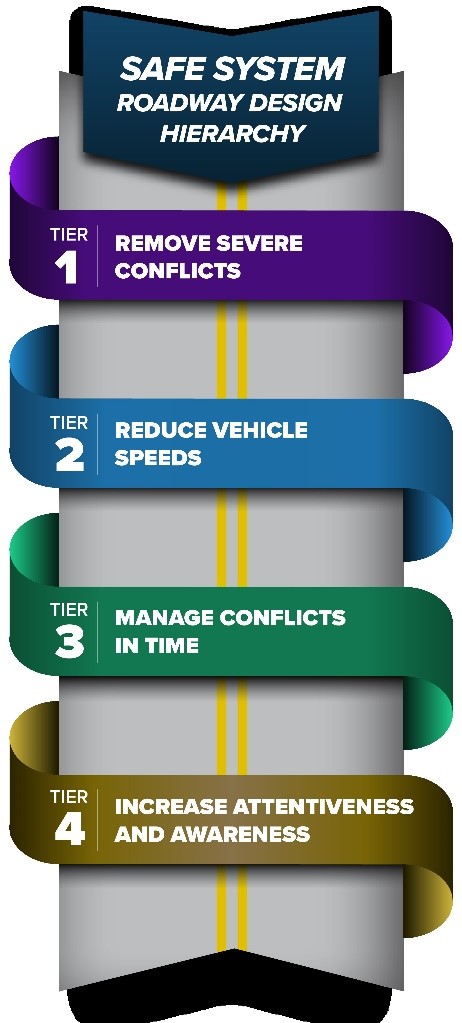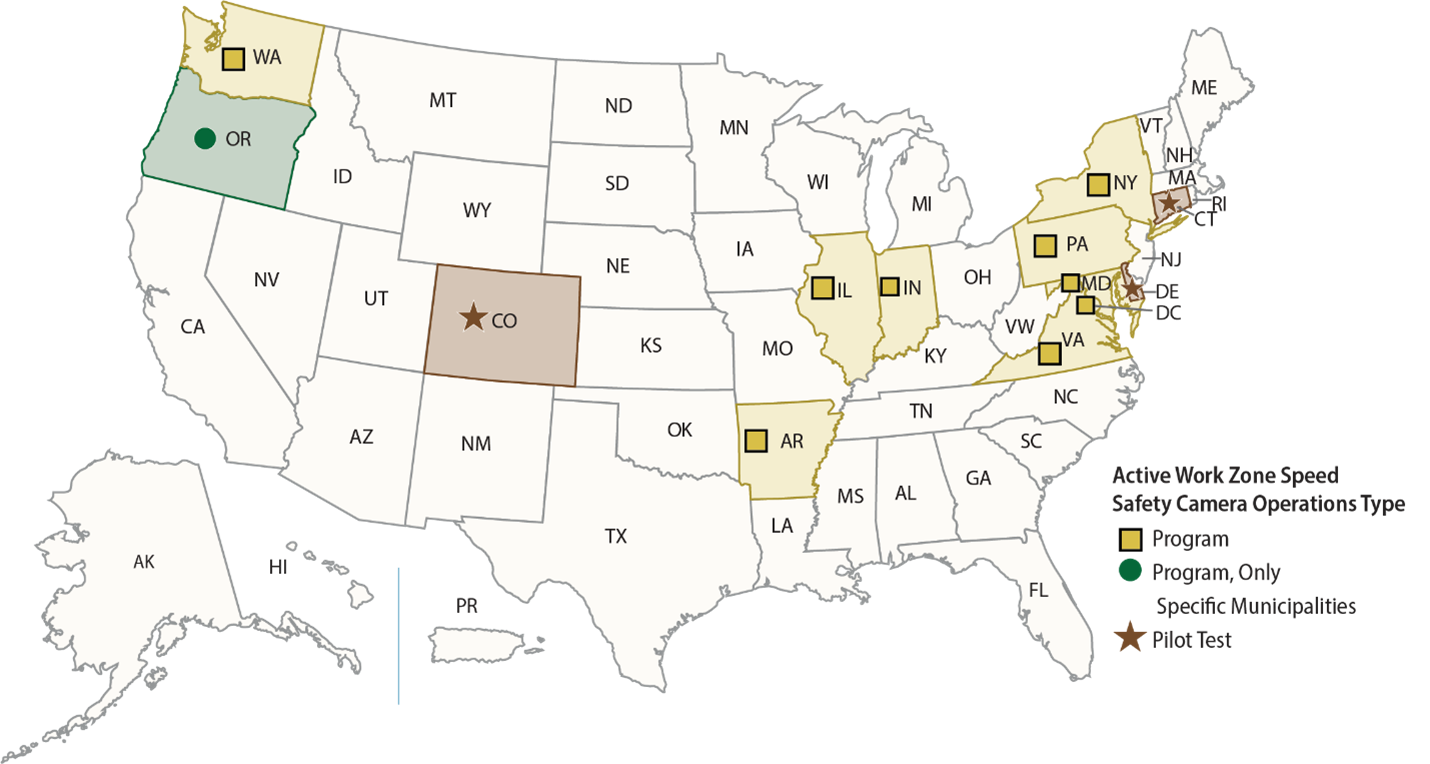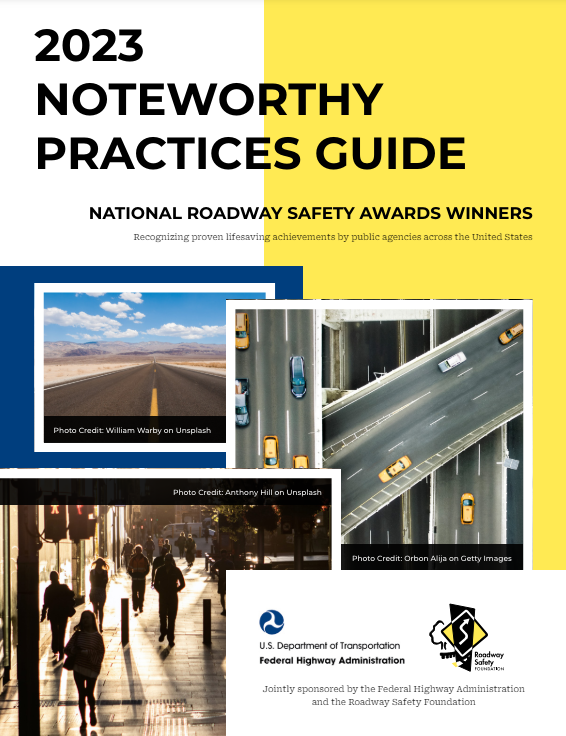
Safety Compass Newsletter
A Publication of the Federal Highway Administration Office of Safety
Summer 2024: Volume 18, Issue 2
In this issue:
A Message from the FHWA Associate Administrator for Safety
SAFE SYSTEM APPROACH
SAFETY SUCCESS STORIES
Online FHWA Safety Database Lets You Learn from Others
2023 National Roadway Safety Awards Noteworthy Practices Guide
RESEARCH AND REPORTS
Complete Streets: Safety Analysis
Guide for Intersection Control Evaluation
Speed Safety Cameras – A Proven Countermeasure to Improve Work Zone Safety
Using Operations Data and Real-Time Operations Strategies for Proactive Safety Intervention
TECHNICAL ASSISTANCE
Safety DATA Teams Consolidates Technical Assistance for Safety Data Management
Highway Safety Improvement Program Questions & Answers Published
Attend & Watch FHWA’s Equity in Roadway Safety Webinar Series
FUNDING OPPORTUNITIES
Competitive Grant Funding Matrix Now Available
Safe Streets for All Application Final Deadline
Operation Lifesaver, Inc. Awards $200K for Crossing Safety Public Awareness Campaigns in 10 States
IN CASE YOU MISSED IT
LOOK FOR FHWA AT THESE ROADWAY SAFETY EVENTS
Message from the Associate Administrator for Safety

Robert Ritter, Associate Administrator for Safety
Greetings from the Office of Safety at the Federal Highway Administration. I’m pleased to share my first message since being selected to serve as the Associate Administrator for Safety.
I’ve been privileged to be involved in roadway safety for most of my professional career. Safety is foundational; it is the underlying imperative for our transportation system. One of the biggest lessons I’ve learned is that to truly make a difference, everyone in transportation—regardless of their position or portfolio—needs to play an active role in saving lives on our roadways. I am fortunate to serve at U.S. DOT and FHWA, with safety-focused leaders, where we are well positioned to do this cross-cutting, transformational work. We have a national reach, strong partnerships and deep expertise that can improve safety, from planning and design to construction, operations, and maintenance.
We are living in a time when safety must be the priority. It’s not a question of whether we are building and maintaining safe roads, but how can we make every project safer; and safer for all road users. The number of people who die on our roadways proves that this is a public health crisis. It demands our focus. The most recent national numbers reported by the National Highway Traffic Safety Administration estimate that 40,990 people died in motor vehicle traffic crashes in 2023. Although we have now seen 8 consecutive quarters of decline, we have a long way to go. It is wrenching to think about so many lives cut short and the exponentially larger number of loved ones left behind.

What drew me to the field of engineering is the ability to solve problems and improve lives. In my current role, I can go one step further and save lives too. It is hard work, but I am cautiously heartened. The 2023 crash fatality estimate decreased by about 3.6 percent from the prior year; 2024 could see continued declines. But even more promising is the work being done at the State and local levels to systematically implement the researched-backed engineering solutions we have at our disposal, such as Proven Safety Countermeasures.
We know how to design safe roads that operate at safe speeds and protect people in and out of vehicles. Through our Complete Streets work, FHWA is helping transportation agencies reimagine roadway networks so that people feel safe, regardless of their means of travel. And through investments from various programs—whether it’s the Highway Safety Improvement Program or Safe Streets and Roads for All (SS4A)—States, Tribal, and local governments are planning for and implementing life-saving changes to their roadway infrastructure. Just this past May, the U.S. DOT announced the first set of 2024 SS4A grants—nearly $64 million for safety plans and demonstration projects to 99 communities in 34 States.
Wherever I go, my message is simple: reaching zero roadway fatalities is a shared goal, and a shared responsibility. As you think about your own sphere of influence, I hope the materials below and the others we have developed will prompt conversation, inform current projects, make it easier to integrate safety throughout the roadway lifecycle and continue to make our system safer for all users.
Robert Ritter
Associate Administrator for Safety
Safety Culture – Watch and Discuss
FHWA has produced a new 6-minute video that shows what a strong organizational safety culture looks like. The animated short features two fictitious transportation agencies working to implement road improvement projects. Play How Do You Know You have a Strong Road Safety Culture? at your next meeting or presentation to determine how strong your organization’s safety culture is, and start talking about how everyone can work to improve it. Watch now!Implementing the Safe System Approach on Roadways

The Safe System Roadway Design Hierarchy. (Source: FHWA)
For practitioners working toward zero roadway fatalities through the implementation of the Safe System Approach (SSA), the FHWA Office of Safety released two new tools—one to assist with project selection, the other to help stakeholders assess their policies.
Each tool is formatted as a user-friendly spreadsheet, and both were developed through extensive research of national and international best practices for measuring their relative alignment with the Safe System Approach.
- Safe System Project-Based Alignment Framework: provides practitioners with a means of contrasting potential roadway improvements relative to one another through a quantitative scoring matrix and qualitative safety prompts.
- Safe System Policy-Based Alignment Framework: helps agencies assess policies, plans, processes, programs, and documents in a holistic manner through a Safe System lens.
These two resources are companions to the recent publication, Safe System Roadway Design Hierarchy: Engineering and Infrastructure-related Countermeasures to Effectively Reduce Roadway Fatalities and Serious Injuries (FHWA-SA-22-069). FHWA can provide workshops on the Safe System Design Hierarchy or on applying the Safe System Alignment Frameworks. Learn more about these training opportunities.
Online FHWA Safety Database Lets You Learn from Others
As your transportation agency looks to address roadway safety challenges—like speed or roadway departure—a good first step is to learn from others. FHWA’s Roadway Safety Noteworthy Practices Database lets you do that. This free, online resource contains more than 300 case studies and is searchable by topic, State, and year. Visit it the next time you’re looking for inspiration on how to address or implement effective safety solutions. Bookmark the Roadway Safety Noteworthy Practices Database today.
2023 National Roadway Safety Awards Noteworthy Practices Guide
The Roadway Safety Foundation (RSF) has posted the 2023 Noteworthy Practices Guide, which summarizes the successful safety efforts of the National Roadway Safety Awards recipients. The biennial competition—which is sponsored by FHWA and RSF—recognized achievements in roadway safety from Acadiana Planning Commission, Florida DOT, Illinois Tollway, North Carolina DOT, Texas DOT, Caltrans, Delaware DOT, Minnesota DOT, Port Authority of NY & NJ, South Jersey Transportation Planning Organization, Nevada DOT, and Virginia DOT.
Complete Streets: Safety Analysis
The ability to fully quantify the expected safety benefits of Complete Streets transformations using crash-based, data-driven safety analysis (DDSA) methods, such as those in the Highway Safety Manual (AASHTO 2010), is limited. The lack of crash modification factors (CMFs) for many Complete Streets treatments is a primary reason for this limitation.
A recent report by FHWA, Complete Streets – Safety Analysis (FHWA-HRT-24-074) provides practitioners and stakeholders with a resource that identifies and describes current capabilities, best practices, and future data and analysis needs for quantifying the safety-performance effects of multiple safety treatments that agencies implement simultaneously during the conversion of typical streets to Complete Streets. Read the full report or a two-page summary (FHWA-HRT-24-041) to learn more. For additional information, contact In-Kyu Lim (FHWA).
Mid-block crossing enhanced with rectangular rapid flashing beacons are one of several Complete Streets treatments to enhance pedestrian safety. (Source: FHWA)
Guide for Intersection Control Evaluation
(Source: FHWA)
Recently, the National Academies of Sciences, Engineering, and Medicine posted Report 1087, Guide for Intersection Control Evaluation (ICE) through the National Cooperative Highway Research Program (NCHRP). This guide incorporates processes, objective performance metrics, and tools to help agencies provide consistent and objective ICE. In addition to the guide, the project produced nine implementation tools to facilitate States’ use of the guide, including the ICE Process Tool and the Planning and Preliminary Engineering Applications Guide Tool for ICE.
A growing number of transportation agencies are developing and adopting ICE policies. Virginia, Ohio, and Colorado recently published ICE procedures and tools, bringing the number of States to adopt formalized ICE policies and procedures to 15. While there are differences among the States’ policies and procedures, they are consistent in emphasizing transparency, flexibility, and adaptability. The NCHRP Guide makes it possible for agencies currently without an ICE policy or procedure to streamline development and adoption while also using the ICE tools as starting points.
Agencies with ICE policies are realizing several benefits, including:
- Implementation of safer, more balanced, and more cost-effective solutions.
- Consistent documentation that improves the transparency of transportation decisions.
- Increased awareness of innovative intersection solutions and emphasis on objective performance metrics for consistent comparisons.
- The opportunity to consolidate and streamline existing intersection-related policies and procedures, including access or encroachment approvals, new traffic signal requests, and impact studies for development.
To learn more about ICE, visit the FHWA ICE website or contact Jeff Shaw (FHWA).
Speed Safety Cameras – A Proven Countermeasure to Improve Work Zone Safety
Speed safety cameras (SSCs) are a proven safety tool that jurisdictions may consider as part of a comprehensive speed management program to target speeding-related safety problems.
As of March 2024, 11 States and the District of Colombia have passed legislation (or laws) allowing the use of SSCs in work zones (see figure). While work zone SSC programs in Illinois and Maryland have demonstrated successes for more than 15 years, all other active work zone SSC programs were established within the last 6 years. As an example, the Pennsylvania DOT and Pennsylvania Turnpike Commission conducted a successful 5-year work zone SSC pilot program beginning in 2018, demonstrating reduced speeds and improved safety in work zones when SSCs were deployed; the program was re-authorized in 2023.

Map showing active work zone speed safety camera operations in the United States as of March 2024. (Source: FHWA)
The joint FHWA-NHTSA Speed Safety Camera Program Planning and Operations Guide was published in 2023 and describes steps and activities for deploying an SSC program. The FHWA Identification of National Work Zone Safety Objectives and Activities: Summary Report includes SSCs as part of a strategic objective to minimize driver behaviors that contribute to work zone crashes. Additional work zone management training, regulations, resources, and tools are available on the FHWA Work Zone Management website and the National Work Zone Safety Information Clearinghouse website, which highlights SSCs within the Smart Work Zones Topic of Interest.
For more information on work zone safety, contact Martha Kapitanov (FHWA).
Using Operations Data and Real-Time Operations Strategies for Proactive Safety Intervention
Work is underway on an FHWA project to explore the use of real-time or near real-time roadway operations data (e.g., speed changes, queues, near conflicts, etc.) to identify short-term safety countermeasures.
Recognizing that safety analysis often relies on historical crash data and annual average daily traffic (AADT) volumes to prioritize countermeasures, FHWA is working on a project to advance the use of short-term safety interventions based on current and forecasted operational conditions. This project will result in a final report, webinar, fact sheet, and three research needs statements, which will be completed later in 2024. Visit the safety page of Organizing and Planning for Operations website to view prior FHWA work on coordinating Operations and Safety.
For more information on the project or the research needs topics being considered, contact Jim Hunt (FHWA) or Anyesha Mookherjee (FHWA).
Safety DATA Teams Consolidates Technical Assistance for Safety Data Management
Safety data are essential for data-driven safety analysis (DDSA) and a core component of a Safe System approach. Proactively collecting data today leads to identifying new trends as well as the determining the effectiveness of new solutions. In 2022, FHWA launched the Data and Analysis Technical Assistance (DATA) Teams program to consolidate several safety data initiatives—like the Safety Data and Analysis Technical Assistance Program (SDATAP) and Model Inventory of Roadway Elements (MIRE) technical assistance effort—into one program. DATA Teams can provide resources to safety data professionals across the country. This includes the capability to support FHWA, State, Tribal, and local safety professionals as they develop their MIRE Fundamental Data Elements (FDE). The FDEs consist of a required subset of data on all publicly owned and maintained roads categorized by roadway functional classification and surface type. By September 2026, States will be required to have access to FDEs on public roads.
After this first year in 2023, DATA Teams completed work in Kansas, Montana, and North Carolina. These efforts helped agencies accomplish various tasks that included technical assistance in data management, graphic development, crash database planning and migration, development of machine learning (ML) models, and review of ML data-derived for specific needs.
Kansas
In Kansas, DATA Teams assisted the Kansas Department of Transportation (KDOT) in piloting a method for acquiring surface type information on publicly owned and maintained roads. After reviewing the latest literature, the team determined that using aerial imagery collected by the State’s 911 program provided an adequate resource to test surface type classification schemes, and ML models can be used to efficiently and reliably classify the type of roadway surface. Through a combination of sampling of paved and unpaved roads, manual quality control reviews, and implementation of an open-source, ML-based predictive method with a Bayesian component allowed the Team to develop and validate a model that classifies roadway surface type (paved or unpaved) with 95-percent accuracy. KDOT can now use this model as-is to classify their road network or refine it to improve model accuracy and functionality.
Montana
The Montana Department of Transportation (MDT) requested technical assistance from FHWA while planning a possible transition of the State’s crash database from the Montana Highway Patrol (MHP). The DATA Team assisted MDT in a multifaceted approach by interviewing MDT and MHP stakeholders to understand the situation, identifying case studies from other States with similar administrative structures to Montana, and providing noteworthy practices and recommendations for the transition. Topics included questions about resources required to make the transition (including full time staffing needs), legal considerations, technologies, potential funding mechanisms, and management of the transition. After interviewing stakeholders and reviewing their recommendations, the effort noted example legislation that could be helpful to Montana, possible Federal funding mechanisms (including the State Electronic Data Collection program), staffing estimates, and relevant technologies.
North Carolina
In North Carolina, DATA Teams supported the North Carolina Department of Transportation (NCDOT) in piloting a method for acquiring intersection related MIRE attributes. The Team acquired pavement marking features, such as crosswalks and turn lane markings, derived from proprietary aerial imagery and ML models, and tested a sample study area in Greensboro, NC. The sample of data contain information about the identified pavement marking, the marking’s spatial location, and the confidence estimate associated with the ML classification prediction. Data reviewed from testing can be used to supplement and populate attributes in NCDOT Traffic Safety Unit’s intersection inventory and enhance the accuracy of the State’s MIRE FDEs.
After assessing a reasonable level of confidence in the data’s accuracy and completeness, the team acquired updated data for the cities of Greensboro, Goldsboro, and Marion. The selected municipalities represented North Carolina’s varied geography and urban contexts. The Team integrated the point features derived from imagery as attributes in the intersection inventory, such as identifying new roundabouts, midblock crossings, traffic signals, and all-way stops, as well as turn lane information on approaches. The DATA Team’s findings demonstrated the potential MIRE updates that could apply to existing data inventories, as well as a general level of potential effort.
If you are interested in learning more about Federal and State efforts to improve the nation’s safety data and enhance data analysis capabilities, visit FHWA’s Roadway Safety Data Program website. If you are interested in requesting assistance from the DATA Teams program, potentially providing or receiving peer assistance from fellow State agencies, or attending a future MIRE peer exchange, contact Sarah Weissman Pascual (FHWA).
Highway Safety Improvement Program Questions & Answers Published
The Bipartisan Infrastructure Law (BIL) made several changes to the HSIP program, which were described in the HSIP Eligibility Guidance dated February 2, 2022. FHWA recently published a new set of HSIP Q&As to further explain the updates. Various stakeholders submitted these questions to the Office of Safety after the BIL and HSIP Eligibility Guidance became available. The questions focus on general HSIP eligibility, Specified Safety Projects, and Special Rules. Read the HSIP Q&As.
Attend & Watch FHWA’s Equity in Roadway Safety Webinar Series
Register today for the upcoming webinar “Roadway Safety for People Experiencing Homelessness,” scheduled for September 4, 2024, from 1 to 3 p.m. ET. Visit the Equity in Roadway Safety Webinar Series web page, where you can view recorded webinars and subscribe to the Equity in Roadway Safety email list to receive important announcements about upcoming webinars.
Competitive Grant Funding Matrix Now Available
The Bipartisan Infrastructure Law authorized a variety of competitive grant programs that USDOT and FHWA use to fund an array of transportation projects and activities. USDOT developed a matrix to assist potential applicants—including State Highway agencies, metropolitan planning organizations, local governments or agencies, Tribes, territories, and protectorates—in determining their eligibility for each funding program. The Competitive Grant Funding Matrix lists the available grant programs along with links to their respective grant information pages. Each program can be matched to the potential applicant types eligible for funding. Potential applicants should review program-specific guidance to make informed decisions about applying for funding under each program. Find funding.
Safe Streets for All Application Final Deadline
Mark your calendar! The application cutoff date for the SS4A Planning and Demonstration Grant portion of the SS4A is August 29, 2024, by 5 p.m. ET. This is the final deadline for the 2024 round of grant funding. For more information about SS4A, please visit the following resources:
- “How to Apply” Webinar Recordings and Slides
- SS4A Pre-Application Action Plan Review
- SS4A Eligible Applicants
- Matching Funds for SS4A Grants
- Eligible Supplemental Planning and Demonstration Activities
- FAQ
Operation Lifesaver, Inc. Awards $200K for Crossing Safety Public Awareness Campaigns in 10 States
Operation Lifesaver, Inc. in partnership with FHWA, announced $200,000 in competitive crossing safety awareness grants to Operation Lifesaver programs in 10 States. The FHWA-funded grants will be awarded to Operation Lifesaver organizations in California, Illinois, Indiana, Missouri, New York, Ohio, Pennsylvania, South Carolina, Tennessee and Texas. The grants will be used for a variety of crossing safety public education projects and campaigns that will encompass See Tracks? Think Train!® Week,September 23–29, 2024. For more information on the grant recipients and their projects, please visit the Operation Lifesaver web page.
National Work Zone Awareness Week (April 15–19, 2024)
For the first time in several years, the number of work zone fatalities decreased nationally, dropping 7 percent, from 963 deaths in 2021 to 891 in 2022. Now in its 25th year, National Work Zone Awareness Week (NWZAW) served as an annual reminder that work zone safety and mobility for all road users—motorists, commercial motor vehicles, and vulnerable road users like pedestrians, bicyclists, and highway workers on foot—is a significant issue that must be addressed.
This year’s theme was, “Work zones are temporary. Actions behind the wheel can last forever.” Visit the FHWA NWZAW webpage to learn about the activities that were sponsored by FHWA, Maryland DOT State Highway Administration, and other collaborators. An FHWA NWZAW fact sheet is also available, and additional work zone management training, regulations, resources, and tools can be found on the FHWA Work Zone Management webpage and National Work Zone Safety Information Clearinghouse.
For more information, contact Martha Kapitanov (FHWA).

2024 National Work Zone Awareness Week poster. (Source: FHWA)
2024 Traffic Records Forum. San Diego, California. August 11–14, 2024. This annual event is for data analysts, State and local law enforcement officials, engineers, motor vehicle officials, emergency medical services providers, judicial administrators, and highway safety professionals from across the United States and international communities. Sessions are focused on the latest safety data collection methods and best practices, including performance goals/measures, standards and guidelines, new technologies and ideas, and more.
Association of Pedestrian and Bicycle Professionals 2024 Conference. Detroit, Michigan. August 12–14, 2024. Join colleagues, friends, and experts for training, workshops, and panel sessions focused on innovative mobility designs. Featuring mobile sessions that will tour the city on foot, bike, and via transit, attendees will explore Detroit while learning about the city’s Transportation Innovation Zone, which will be designed to attract and more readily permit mobility innovation.
AASHTO Safety Summit and Peer Exchange. Houston, Texas. October 15–17, 2024. The 2024 AASHTO Safety Summit and Peer Exchange will again bring together State DOT leaders, management, and practitioners, as well as transportation professionals in the public, private, non-profit, and academic sectors, to share notable examples of programs, policies, and projects that incorporate safety for all road users throughout the roadway lifecycle and agency activities.
The Safety Compass Newsletter
is a publication of the U.S. Department of Transportation, Federal Highway Administration (FHWA).
FHWA publishes the Safety Compass newsletter 3 times a year. We can be reached at:
FHWA Office of Safety
1200 New Jersey Ave. SE
Room E71-320
Washington, DC 20590
The Safety Compass is available online at the FHWA Office of Safety web site at: https://safety.fhwa.dot.gov/newsletter/safetycompass/.
The purpose of this newsletter is to increase highway safety awareness and information, and to provide resources to help save lives. We welcome your comments and ideas for content that might be of value to the highway safety community. To share them, reach out to Tina Tennessen at: christina.tennessen@dot.gov.



